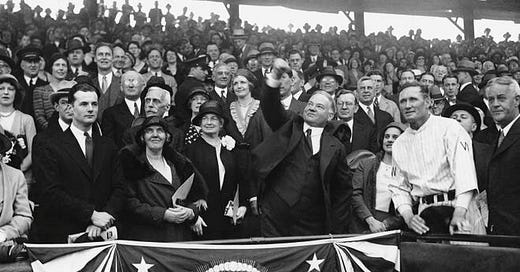The Old Opening Day Tradition
There’s a lot that we’ve forgotten over the years.
For a variety of reasons, I’ve decided to set my sights back on 1930. I spent a bit of time the other day reading through contemporary newspaper articles about the festivities planned for the first game of the season that year.
The Boston Red Sox went over to Washington D.C. to face the Senators on April 14, 1930. It was a Monday, and the game was the only scheduled game for that day.
Despite the economic problems that have tarnished his legacy, President Hoover was actually a big sports fan, and clearly adored baseball. In fact, this photo, taken on opening day a year later (1931), has become legendary:
But there are a few things about the 1930 lid lifter that surprised me.
The Game Started At 3 PM
I’ve mentioned this before, but it ought to be repeated.
Games started later than you think in the era before lights.
This game, for example, started at 3 PM — and nobody seemed to bat an eye:
That should strike you as odd. In fact the sun was scheduled to go down around 6:30 PM that day:
In other words — when you look back at games from this era and see them finish in 2 hours or less, you need to realize that the players had no choice but to play quickly. There were no lights to save them, and there weren’t many daylight hours available.
This particular game couldn’t have started much earlier even if they wanted it to, of course. The remaining general admission tickets went on sale at 9 AM, and the gates opened up at noon. Nick Altrock and Al Schacht entertained the crowd, after which a few marching bands performed for a few hours before President Hoover finally was scheduled to arrive around 2:30.
This might be enough to make you dizzy — but it’s actually nothing compared to the lengthy festivities the game saw back in the pre-World War I era. We’ll talk more about that later.
One thing to keep in mind is that visibility likely wasn’t great for batters, what with all the late starting times and the shadows and so on. But, then again, 1930 wasn’t exactly a pitcher’s year.
Radio Was Huge
The Red Sox - Nationals (or Senators, depending on the newspaper) opening game was broadcast on two radio stations at once.
It seems that WMAL in the Washington D.C. area was a CBS affiliate in 1930. Broadcasting pioneer Ted Husing broadcast the game for CBS, and his broadcast was relayed over a pretty wide section of the east cost, including New York City, of course:
Meanwhile, as noted above, WRC seems to have been an NBC affiliate, and I think that network also relayed the broadcasting across a sizeable chunk of the country — though apparently not to the west coast.
Radio was huge in 1930, of course. In fact, the radio reciever ads remind me a lot of the ads for television sets in 1949:
The Preseason Predictions Were Off
As usual, most of the prognosticators simply predicated that the teams would do the same thing in 1930 that they had done in 1929:
The Athletics did repeat in the American League, of course — but Washington wound up finishing second. We should’ve taken those 50 to 1 odds.
Meanwhile, the Cardinals surprised everybody by dethroning the mighty Cubs in the National League. Goes to show you what the preseason predictions are really worth.
Finally, to give you an idea of just how long ago 1930 really was, take a look at what used cars cost in those days:
Of course, today’s cars are a little bit better at starting and continuing to function without stalling than the cars of the 1920s.















A Radio Weather Forecast! Aimed not at attendees but listeners, and including a description of the day's weather map (!), supplied by a local member of the AMS, instead of what was then the U.S. Weather Bureau. Opening Day was a big deal indeed.
Losing second baseman Rogers Hornsby to injury for much of 1930 was a big reason why the Cubs didn’t repeat as NL champs in a close NL race